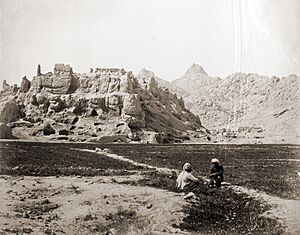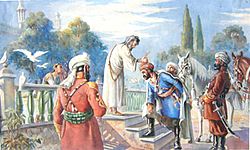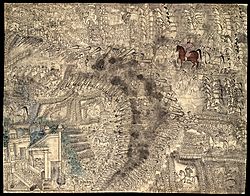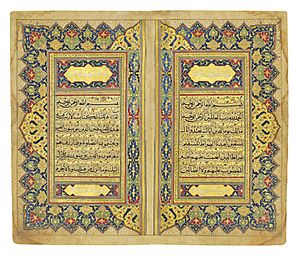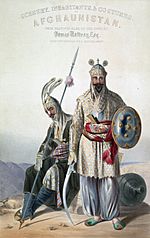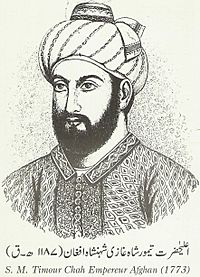Ahmad Shah Durrani facts for kids
Quick facts for kids Ahmad Shah Durraniاحمد شاه دراني احمد شاه درانی |
|||||||||
|---|---|---|---|---|---|---|---|---|---|
| Padishah Ghazi Shāh Durr-i-Durrān ("King, Pearl of Pearls") |
|||||||||
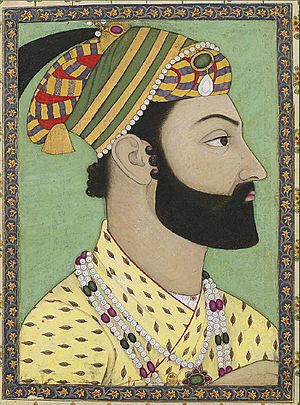
Portrait of Ahmad Shah Durrani, c. 1757
|
|||||||||
| 1st Emir of the Durrani Empire | |||||||||
| Reign | 1747–1772 | ||||||||
| Coronation | July 1747 | ||||||||
| Predecessor | Position established | ||||||||
| Successor | Timur Shah Durrani | ||||||||
| Born | Ahmad Khan Abdali 1720–1722 Herat, Sadozai Sultanate of Herat (present-day Afghanistan) or Multan, Mughal Empire (present-day Pakistan) |
||||||||
| Died | (aged 49–52) Maruf, Kandahar Province, Durrani Empire (present-day Afghanistan) |
||||||||
| Burial | June 1772 Tomb of Ahmad Shah Durrani, Kandahar, Afghanistan 31°37′10″N 65°42′25″E / 31.61944°N 65.70694°E |
||||||||
| Spouse | Hazrat Begum Iffat-un-Nissa Begum |
||||||||
|
|||||||||
| Dynasty | House of Durrani | ||||||||
| Father | Mohammad Zaman Khan Abdali | ||||||||
| Mother | Zarghona Anaa | ||||||||
| Religion | Sunni Islam | ||||||||
Ahmad Shah Durrani (also known as Ahmad Shah Abdali) was a very important leader in the 1700s. He founded the Durrani Empire and is often called the founder of modern Afghanistan. In July 1747, a big meeting of leaders (called a loya jirga) chose him as the King of the Afghans in Kandahar.
Ahmad Shah, with help from Pashtun tribes, expanded his empire. He moved east into India, west into Iran, and north into Central Asia. In just a few years, his control stretched from Khorasan in the west to North India in the east. It also went from the Amu Darya river in the north to the Arabian Sea in the south.
After becoming king, Ahmad Shah took the special name Shāh Durr-i-Durrān, which means "King, Pearl of Pearls." He also changed the name of his tribe from "Abdali" to "Durrani" after himself. His tomb is in the center of Kandahar. Many Afghans call him Ahmad Shāh Bābā, meaning "Ahmad Shah the Father."
Contents
Early Life
Ahmad Shah's father, Mohammad Zaman Khan, was the leader of the Pashtun Abdali tribe and the governor of Herat. His mother, Zarghona Anaa, was from the Alakozai tribe. Ahmad was born around 1720–1722 in either Herat, Afghanistan, or Multan, Pakistan. This was around the time his father passed away.
In 1729, the Abdali forces gave up to Nader Shah Afshar, a powerful new ruler in Persia. However, they soon rebelled and took over Herat. Ahmad Shah and his brother Zulfiqar later sought safety in Kandahar. They were then held as political prisoners by Hussain Hotak, the ruler of that area.
Nader Shah had been adding Abdali soldiers to his army since 1729. After Nader Shah conquered Kandahar in 1738, Ahmad Shah and his brother were freed. They were given important roles in Nader Shah's government. Ahmad Shah became a personal helper to Nader Shah. He later became the commander of the Abdali Regiment, a group of four thousand cavalry soldiers. This regiment was part of Nader Shah's army when he invaded the Mughal Empire in India in 1738.
It is said that Nader Shah saw great talent in Ahmad Shah. A popular story says that in Delhi, Nader Shah told Ahmad Shah that he would become king after him. Nader Shah chose him because of his "impressive personality and bravery."
Becoming King
Nader Shah's rule ended suddenly in June 1747 when his own guards killed him. Ahmad Shah and his Abdali soldiers were very loyal to Nader Shah. They rushed to his tent but found only his body. Before leaving, Ahmad Shah took the royal seal and the famous Koh-i-Noor diamond. On their way back to Kandahar, the Abdali soldiers all agreed that Ahmad Shah should be their new leader. He then became the ruler of Afghanistan.
One of Ahmad Shah's first actions as chief was to take the special name Shāh Durr-i-Durrān, meaning "King, Pearl of Pearls."
Building the Afghan Empire
Ahmad Shah gave top military jobs to his fellow Durrani (Abdali) tribesmen. However, his army included soldiers from many different groups. These included other Pashtun tribes and non-Pashtun groups like the Qizilbash, Hazaras, Tajiks, Uzbeks, and Baloch.
He began his military conquests by taking Qalati Ghilji and Ghazni. He then took Kabul and Peshawar from the Mughal governors. He also conquered the area up to the Indus River. In 1747, he appointed Muhammad Hashim Afridi as chief of the Afridi tribe in Peshawar. Ahmad Shah went on to conquer Herat in 1750, Balkh and Badakhshan in 1751, and Kashmir in 1752.
He also led two campaigns into Khorasan (1750–51 and 1754–55). During these campaigns, he attacked cities like Mashhad and Nishapur. His forces faced tough battles and suffered losses. In 1754, he invaded again and took Mashhad. He forced the local ruler to give up several areas to the Afghans. He also attacked Nishapur again, and the city was destroyed.
Invasions of India
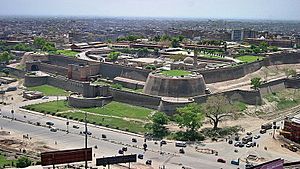
Peshawar was a good starting point for Ahmad Shah's military conquests in India. From 1748 to 1767, he invaded India eight times. In 1748, he crossed the Indus River and captured Lahore. In 1749, he took the Punjab area around Lahore. The Mughal ruler of India gave him Sindh and all of Punjab to prevent an attack on his capital.
With these new lands in the east, Ahmad Shah then moved west. He took Herat in 1750 after a long fight. His forces then pushed into Iran, capturing Nishapur and Mashhad in 1751. After taking Mashhad again in 1754, Ahmad Shah visited a holy shrine and ordered repairs. He then made Khorasan a state that paid tribute to the Durrani Empire. This marked the western border of his empire.
The Third Battle of Panipat
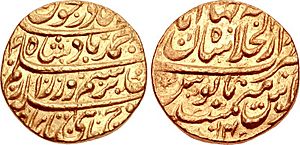
The power of the Mughal Empire in northern India had been weakening since the early 1700s. By 1751–52, the Marathas controlled large parts of India from their capital at Pune. Mughal rule was mostly limited to Delhi. The Marathas wanted to expand their control further north.
Ahmad Shah had previously attacked the Mughal capital and taken valuable treasures. To fight the Afghans, the Maratha leader sent an army. This army managed to push Ahmad Shah's son, Timur Shah, out of India. They brought northwest India, including Peshawar, under Maratha rule. So, when Ahmad Shah returned to Kandahar in 1757, he decided to go back to India. He wanted to fight the Marathas and get back his lost territories.
In 1761, Ahmad Shah began his campaign to regain these lands. His Afghan forces won early battles against the Maratha armies in northwest India. By 1759, Ahmad Shah and his army reached Lahore, ready to face the Marathas. By 1760, the Maratha groups had formed a large army. The Third Battle of Panipat was fought between Ahmad Shah's Afghan forces and the Maratha forces in January 1761. Ahmad Shah won a very important victory.
Central Asia
From the 1600s to the mid-1700s, much of Central Asia was controlled by the Dzungars. The Dzungar Empire was destroyed by Qing China between 1755 and 1758. Many Uighur Muslims, who had been ruled by the Dzungars, supported Qing China. They wanted to be free from Dzungar rule.
After the Qing defeated the Dzungars, two brothers, Burhan-ud-din and Khan Khoja, became rulers in Kashgar. They had promised to be loyal to Qing China. However, they broke their promise and rebelled against the Qing. The Qing armies, with help from loyal Uighurs, defeated the revolt. The brothers fled to Badakhshan. Ahmad Shah Durrani sent troops to Kokand when he heard rumors that Qing China might expand further into Central Asia. However, this expansion did not happen, and Ahmad Shah withdrew his forces. He also sent messengers to Beijing to discuss the situation.
Death and Lasting Impact
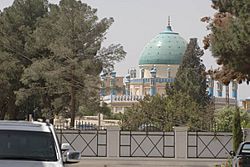
Ahmad Shah may have been hurt in a horse-riding accident in 1768, or he might have developed a health issue that started on his nose. This problem slowly spread to other parts of his face, including his left eye. In his last years, he spent summers in the cooler Margha plain. He passed away from his illness on June 4, 1772, in Maruf, east of Kandahar.
He was buried in Kandahar city, next to the Shrine of the Cloak. A large mausoleum was built for him.
Ahmad Shah's victory over the Marathas greatly changed the history of India. It also affected the plans of the East India Company. His decision not to continue his campaigns deeper into India allowed the Company to gain more power. For almost 50 years after the Third Battle of Panipat, the Company feared another Afghan invasion. This fear led them to send envoys to Persia to prevent any possible Afghan attacks on India.
His successors, starting with his son Timur Shah, found it hard to rule the empire. They faced many enemies and civil wars. Much of the land Ahmad Shah conquered was lost by the end of the 1800s. Timur Shah tried to keep the empire together and fought rebellions. After Timur Shah, his son Zaman Shah Durrani became king. He lost outer territories and faced internal conflicts. Afghanistan became disunited until Dost Mohammad Khan took power in 1826. Dost Mohammad Khan worked to reunite Afghanistan, succeeding in taking back Herat and Principality of Qandahar.
In Pakistan, a short-range ballistic missile called Abdali-I is named in honor of Ahmad Shah Abdali.
Ahmad Shah's Poetry
Ahmad Shah Durrani wrote many poems in his native Pashto. He also wrote some poems in Persian. One of his most famous Pashto poems is called Love of a Nation:
ستا د عشق له وينو ډک سول ځيګرونه
By blood, we are filled with love for you
ستا په لاره کښې بايلي زلمي سرونه
Young people give their lives for you
تا ته راسمه زړګی زما فارغ سي
When I come to you, my heart finds peace
بې له تا مې اندېښنې د زړه مارونه
Without you, worries cling to my heart like snakes
که هر څو مې د دنيا ملکونه ډېر سي
Even if I conquer many countries in the world,
زما به هېر نه سي دا ستا ښکلي باغونه
I will never forget your beautiful gardens
د ډیلي تخت هېرومه چې را ياد کړم
I forget the throne of Delhi when I remember,
زما د ښکلي پښتونخوا د غرو سرونه
The mountain tops of my beautiful Pashtunkhwa
د فريد او د حميد دور به بيا سي
The times of Farid and Hamid will return,
چې زه وکاندم پر هر لوري تاختونه
When I launch attacks everywhere
که تمامه دنيا يو خوا ته بل خوا يې
If I must choose between the whole world and you,
زما خوښ دي ستا خالي تش ډګرونه
I will gladly choose your empty deserts
Personal Life
During Nader Shah's invasion of India in 1739, Ahmad Shah was with him in the Red Fort of Delhi. A wise man named Asaf Jah I saw him and said that Ahmad Shah was "destined to become a king." When Nader Shah heard this, he supposedly cut Ahmad Shah's ears with his dagger, saying, "When you become a king, this will remind you of me." Other stories say Nader Shah did not believe it but asked Ahmad Shah to be kind to his family if he ever became king.
|
|||||||||||||||||||||||||||||||||||||||||||||||||||||||||||||||||||||||||||||||||||||||||||||||||||||||||||||||||||||||||||||||||||||||||||||||||||||||||||||||||||||||||||||||||||||||||||||||||||||||||||||||
See also
 In Spanish: Ahmad Shah Durrani para niños
In Spanish: Ahmad Shah Durrani para niños


